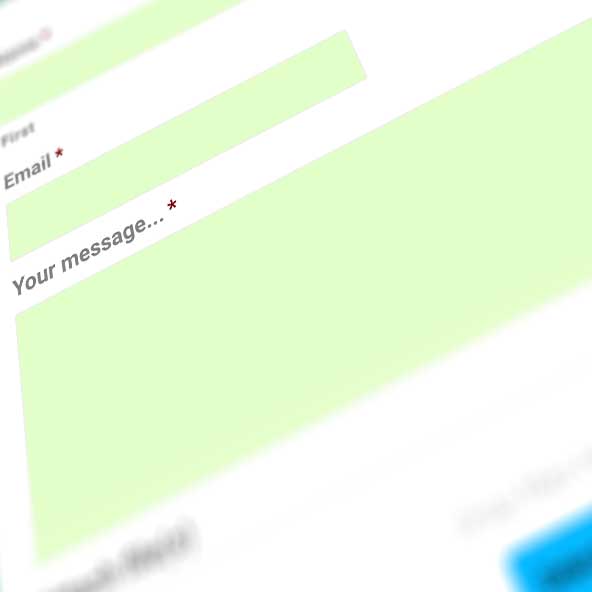Improve Your Website Contact Form
Updated: February 1, 2019 • By Lena Shore
Filed under: Web Design

Your contact form is a crucial part of your website. As your major source of connecting with clients, it is important to make sure your form is doing a good job. Periodically, you should apply a critical eye and see if it is working well and if you can improve upon it.
Do you even have a contact form?
Many websites don’t even have a contact form. Website owners post their email address on the contact page and leave it at that. This is not a great practice for a few reasons.
Posting your email address publicly will get it harvested by spammers. They will use your email address to send you spam and/or sell it to other unsavory internet characters. Once the cycle starts, it’s difficult to break. We all get enough garbage in our inbox and adding to it just makes it harder to find the emails you really care about — like those from customers!
Plenty of visitors use webmail and don’t have a mail application on the computer they are using. If they want to email you, they will have to take the extra step to copy your email address, login to webmail, and paste (or retype) your email address into a new message. Don’t give your customers extra work to do just to contact you.
Adding a contact form helps prevent spam and makes it easier for your customers to contact you.
How is your current form working?
When is the last time you tested your email form to make sure you were getting the messages? Many things can happen, from updates to new spam settings at your service provider that can block your form submissions. Make it a habit to periodically fill out all your contact forms to ensure safe delivery.
Do you get a lot of spammy emails from the form on your website? A few tweaks might prevent you from spending time sifting through the garbage. Adding rules or code to your form can create a mini-watchdog to keep spammers out. You might think that adding a CAPTCHA is the answer — but there are better ways that don’t inconvenience your user.
A few other things to ask yourself:
- Is your form easy to find and in a logical place or is it buried in a subpage somewhere?
- Did you name it something clever? Will people know that the “What’s Up?” link is a contact form? Now might not be the time to be clever.
- Does your form work on mobile devices?
Does your form help you?
How effective is your form for your business? Does it go to the right person? Do you wish it went to multiple people? Would it be a big timesaver to have the form delivered to the right person based upon the client’s choices on the form?
These are small adjustments that could make a big difference for your employees over time.
Does your form help your customer?
A contact form should be treated differently than an order form.
Contact forms should be simple to fill out. They should encourage the user to fill them out and not turn that user off. Customers want simplicity. Make sure each item on your form has a purpose. There are some items that people hate seeing on a form. They hate them so much, they will not even start filling out your form, much less complete it. You should avoid them when possible.
Seeing any of these might prevent them from filling out the form in the first place.
- CAPTCHA
- Phone number (If you must ask for a phone number, make this field optional so your visitor has a choice. According to this study, doing this decreases abandonment from 39% to just 4%.)
- Age
- Location
- Auto sign-ups to newsletters (with no way to opt out)
- Lots of questions (A study by Hubspot shows that reducing the number of fields from four to three brings a 50 percent improvement in conversion rate.)
If you have a form that can’t be brief, such as an order form, you can do things to make it feel more simple.
- Include conditional logic. This means that form fields will only appear when the customer has answered a previous question a certain way. For instance if you asked “Do you have pets?” and they select “yes” they will then see “What kind of pet?”. You can handle individual entries or entire sections this way. It really helps to show the customer only what they need.
- Your contact form copy should inform and direct. Tell your audience how and why they should contact you. Is your contact information only for potential customers? Can they contact you to offer feedback? Do you accept business inquiries? When will they hear back from you?
- Consider adding creative CTA (Call to Action) copy to encourage visitors to finish submitting their form.
- Offer multiple forms of contact (phone, email, text, chat, etc.)
- Tell people what to expect in terms of a reply. (And make sure they get one that fulfills those terms.)
Find something you want to fix up a bit?
If you have found some areas that don’t work the way they’re supposed to or maybe just need some tightening up, and you think you need some help, feel free to give me a call. my number is 904-438-8389, or you can try out my own contact form. I am always happy to lend a hand!